Effects of Sea Breeze on Urban Areas Using Computation Fluid Dynamic—A Case Study of the Range of Cooling and Humidity Effects in Sendai, Japan
Abstract
:1. Introduction
2. Materials and Methods
2.1. Steps of Study
- (1)
- Arrangement of measured data obtained using equipment at the research laboratory in Sendai. Simultaneous multi-point measurements of temperature and humidity were used to organize the relevant data of the selected target day and representative location.
- (2)
- Verification of the usability of the WRF model. A correlation analysis between the measured air temperature and WRF calculation results was carried out. According to the measured results of the multi-point simultaneous measurements, the temperature distribution map was created using ArcGIS Pro and compared with the temperature distribution map obtained from the WRF calculation results.
- (3)
- Using the values obtained from the calculation results of the WRF model, we conducted a climate analysis and interpretation of the temperature and specific humidity affected by sea breezes.
- (4)
- Mapping the cooling area.
2.2. Measured Data
2.3. Model Setup
| Calculation period | 09:00 (JST) on 15 August 2012 to 09:00 (JST) on 25 August 2012 |
| Vertical grid | 30 layers |
| Domain 1:9 km, dimension 37 × 28 | |
| Horizontal grid (Figure 3) | Domain 2:3 km, dimension 43 × 34 |
| Domain 3:1 km, dimension 31 × 28 | |
| Meteorological data | NCEP re-analysis of global objective data |
| Land data | Digital national land information (resolution of ~1000 m) |
| Microphysics | WSM 6-class graupel scheme |
| Radiation: Longwave | Rapid radiative transfer model |
| Shortwave | Dudhia shortwave |
| PBL scheme | Mellor–Yamada–Janjic TKE scheme |
| Surface scheme | Urban canopy model |
- Firstly, we run the pre-processing system, which is called WPS of the WRF. It should be noted that all the operations can be set in the “namenlist.wps”. This file contained four sections: “&share”, “&geogrid”, “& ungrib” and “&metgrid”. Additionally, these sections should be set one by one. As shown in the figure, it was necessary to define the area location of the study area. After that, we input the base data and set the number of nested domains according to the desired final WRF data resolution and input data resolution. At the same time, the domain size and data of the grid point were also set. This study area was located in Sendai, Japan. The source of the static land data was based on the United States Geological Survey (USGS). The download data were the data in 2014 with a resolution of 30 km. The final resolution was 1 km that was output from WRF. Therefore, we set 3 layers of nesting for this simulation.
- When the operation of pre-processing system was finished, the data that were generated by “&geogrid” and “&ungrib” were merged. As a result, the MET file can be generated. After that, we placed the MET file in the REAL file and created the data link. The WRF results of the three domains were obtained after editing the “namelist.input” and running the “REAL” system. The “namelist.input” contained six parts: “&time_conreol”, ”&domains”, “&physics”, ”&dynamics”, “&bdy_control”, and “&namenlist _quilt”. In the “&bdy_control” boundary control, the value of the specified area was set to 1, which is a default value. The value of the relaxation zone was set to 4, which is determined by the width of the boundary zone. The sum of these two values was the number of rows nudged by the specified boundary value. When we specified boundary conditions, it was only turned on (true) for domain 01, which meant that it must have been false for all other domains. The nested boundary conditions of all three domains were set to be true. The output files of the three domains were obtained after running the system.
- Finally, the calculation results were available after running the WRF system.
3. Results
3.1. Comparison of the WRF Model Results and Actual Measurement Data
3.1.1. Temperature Correlation Analysis
3.1.2. Comparison of Temperature Distributions
- (1)
- The temperature distribution in and around cities.
- (2)
- Did sea breezes affect the temperature rise from coastal areas to inland areas?
- (3)
- Was the temperature at the same level?
- (1)
- The measured temperature values started to increase from 08:00, with high temperatures starting to appear in urban areas, and lower temperatures in inland areas before 09:00, followed by a gradual increase in temperature from coastal to inland areas. The calculation results showed that the temperature values gradually increased from the coastal areas to the inland areas from 09:00, but the urban areas did not show extremely high temperatures.
- (2)
- Due to the mitigation effect of the sea breeze, the temperature measured at 11:00 showed that the temperature rise eased. It lasted until 13:00, when the easing effect began to decrease. The calculations showed that sea breezed had a moderating effect on the temperature rise from 09:00 onwards, with a gradual decline in temperature from inland to coastal areas. As for the measured temperature values, the rise in temperature was moderate along the coast before 13:00, but then reduced over time.
- (3)
- The calculations showed that, from 8:00 to 16:00, the temperatures were underestimated for the urban area, whereas the temperatures around it were similar.
3.2. Climate Analysis for Sendai
3.2.1. Trend of Temperature Difference
3.2.2. Trend of Specific Humidity Difference
3.2.3. Sea-Breeze-Induced Temperature Changes
3.2.4. Sea-Breeze-Induced Humidity Changes
4. Discussion
4.1. Creating an Urban Environment KLIMA-ATLAS
4.1.1. Range of the Cooling Effect of Sea Breezes
4.1.2. Range of Mitigation Effects of Sea Breezes
4.1.3. Range of Mitigation Effects per Hour of Sea Breeze
4.1.4. Summary of Cooling and Mitigation Effects
4.1.5. Range of Specific Humidity Rise Due to Sea Breezes
Author Contributions
Funding
Institutional Review Board Statement
Informed Consent Statement
Data Availability Statement
Acknowledgments
Conflicts of Interest
References
- Parnell, S.; Walawege, R. Sub-Saharan African urbanisation and global environmental change. Glob. Environ. Chang. 2011, 21, S12–S20. [Google Scholar] [CrossRef]
- Kusaka, H.; Hara, M.; Takane, Y. Urban Climate Projection by the WRF Model at 3-km Horizontal Grid Increment: Dynamical Downscaling and Predicting Heat Stress in the 2070’s August for Tokyo, Osaka, and Nagoya Metropolises. J. Meteorol. Soc. Jpn. 2012, 90B, 47–63. [Google Scholar] [CrossRef] [Green Version]
- Santamouris, M. Analyzing the heat island magnitude and characteristics in one hundred Asian and Australian cities and regions. Sci. Total Environ. 2015, 512–513, 582–598. [Google Scholar] [CrossRef]
- Seino, N.; Aoyagi, T.; Tsuguti, H. Numerical simulation of urban impact on precipitation in Tokyo: How does urban temperature rise affect precipitation? Urban. Clim. 2018, 23, 8–35. [Google Scholar] [CrossRef]
- Saitoh, T.S.; Shimada, T.; Hoshi, H. Modeling and simulation of the Tokyo urban heat island. Atmos. Environ. 1996, 30, 3431–3442. [Google Scholar] [CrossRef]
- Wang, S.; Zhu, J. Amplified or exaggerated changes in perceived temperature extremes under global warming. Clim. Dyn. 2019, 54, 117–127. [Google Scholar] [CrossRef]
- Onozaki, K. Population Is a Critical Factor for Global Carbon Dioxide Increase. J. Heal. Sci. 2009, 55, 125–127. [Google Scholar] [CrossRef] [Green Version]
- Georgescu, M.; Moustaoui, M.; Mahalov, A.; Dudhia, J. Summer-time climate impacts of projected megapolitan expansion in Arizona. Nat. Clim. Chang. 2013, 3, 37–41. [Google Scholar] [CrossRef]
- Japan Fire and Disaster Management Agency. The Emergency Conveyance Situation Due to Heat Stroke of 2018 (May to September); Japan Fire and Disaster Management Agency: Tokyo, Japan, 2018; p. 17. (In Japanese)
- Yamamoto, Y. Measures to Mitigate Urban Heat Islands. Environmental and Energy Research Unit. Quaterly Rev. 2006, 18, 65–83. [Google Scholar]
- Corburn, J. Cities, Climate Change and Urban Heat Island Mitigation: Localising Global Environmental Science. Urban Stud. 2009, 46, 413–427. [Google Scholar] [CrossRef]
- United-Nations. World Urbanization Prospects; Department of Economic and Social Affairs, United Nations: New York, NY, USA, 2018. [Google Scholar]
- Lutgens, F.K.; Tarbuck, E.J.; Tusa, D. The Atmosphere; Prentice-Hall: Englewood Cliffs, NJ, USA, 1995. [Google Scholar]
- He, B.-J. Potentials of meteorological characteristics and synoptic conditions to mitigate urban heat island effects. Urban Clim. 2018, 24, 26–33. [Google Scholar] [CrossRef]
- Hopkins, G.; Simmons, C.T. Atmospheres in a coastal city with a slope base setting. J. Geophys. Res. Atmos. 2016, 121, 5336–5355. [Google Scholar] [CrossRef]
- Lopes, A.; Lopes, S.; Matzarakis, A.; Alcoforado, M.J. The influence of the summer sea breeze on thermal comfort in Funchal (Madeira). A contribution to tourism and urban planning. Meteorol. Z. 2011, 20, 553–564. [Google Scholar] [CrossRef] [Green Version]
- Kolokotsa, D.; Psomas, A.; Karapidakis, E. Urban heat island in southern Europe: The case study of Hania, Crete. Sol. Energy 2009, 83, 1871–1883. [Google Scholar] [CrossRef]
- Liu, K.; Wu, Q.; Liu, J. Examining the association between social health insurance participation and patients’ out-of-pocket payments in China: The role of institutional arrangement. Soc. Sci. Med. 2014, 113, 95–103. [Google Scholar] [CrossRef] [PubMed]
- Khan, S.M.; Simpson, R.W. Effect of A Heat Island on the Meteorology of a Complex Urban Airshed. Bound. -Layer Meteorol. 2001, 100, 487–506. [Google Scholar] [CrossRef]
- Shen, L.; Zhao, C.; Ma, Z.; Li, Z.; Li, J.; Wang, K. Observed decrease of summer sea-land breeze in Shanghai from 1994 to 2014 and its association with urbanization. Atmospheric Res. 2019, 227, 198–209. [Google Scholar] [CrossRef]
- Dandou, A.; Tombrou, M.; Soulakellis, N. The Influence of the City of Athens on the Evolution of the Sea-Breeze Front. Bound. -Layer Meteorol. 2008, 131, 35–51. [Google Scholar] [CrossRef]
- Sasaki, Y.; Matsuo, K.; Yokoyama, M.; Sasaki, M.; Tanaka, T.; Sadohara, S. Sea breeze effect mapping for mitigating summer urban warming: For making urban environmental climate map of Yokohama and its surrounding area. Urban Clim. 2018, 24, 529–550. [Google Scholar] [CrossRef]
- He, B.-J.; Ding, L.; Prasad, D. Outdoor thermal environment of an open space under sea breeze: A mobile experience in a coastal city of Sydney, Australia. Urban Clim. 2020, 31. [Google Scholar] [CrossRef]
- Ashie, Y.; Hirano, K.; Kono, T. Effects of sea breeze on thermal environment as a measure against Tokyo’s urban heat island. In Proceedings of the Seventh International Conference on Urban Climate, Yokohama, Japan, 3–29 July 2009; pp. 29–32. [Google Scholar]
- Junimura, Y.; Watanabe, H. Study on the effects of sea breeze for decreasing urban air temperatures in summer. J. Environ. Eng. 2008, 73, 93–99. [Google Scholar] [CrossRef]
- Argüeso, D.; Evans, J.; Fita, L.; Bormann, K.J. Temperature response to future urbanization and climate change. Clim. Dyn. 2013, 42, 2183–2199. [Google Scholar] [CrossRef]
- Hahmann, A.N.; Vincent, C.L.; Peña, A.; Lange, J.; Hasager, C.B. Wind climate estimation using WRF model output: Method and model sensitivities over the sea. Int. J. Clim. 2014, 35, 3422–3439. [Google Scholar] [CrossRef]
- Statistics Bureau of Japan. Available online: http://www.stat.go.jp/english/index.html (accessed on 14 August 2021).
- Junimura, Y.; Watanabe, H. Actual condition of air temperature distribution in city and influence of wind upon the relationship between green coverage ratio and air temperature in summer season: Analysis based on the results of long-term multi-point measurements for coastal city Sendai in Tohoku region. J. Environ. Eng. 2007, 72, 83–88. [Google Scholar] [CrossRef] [Green Version]
- Environment Agency: 2002. Survey and Examination Business Report on Environmental Impact of the Heat Island Phenomenon. 2003; p. 3. Available online: http://www.env.go.jp/air/report/h15-02/ (accessed on 14 August 2021).
- Kaoru, T.M. Analysis on the Effect of Sea Breeze on Summer Diurnal Temperature Distribution Pattern in Hiroshima Plain: Mapping the Sea Breeze Effects for Mitigating Urban Warming; Architectural Institute of Japan: Tokyo, Japan, 2016; Volume 81, pp. 283–293. [Google Scholar]

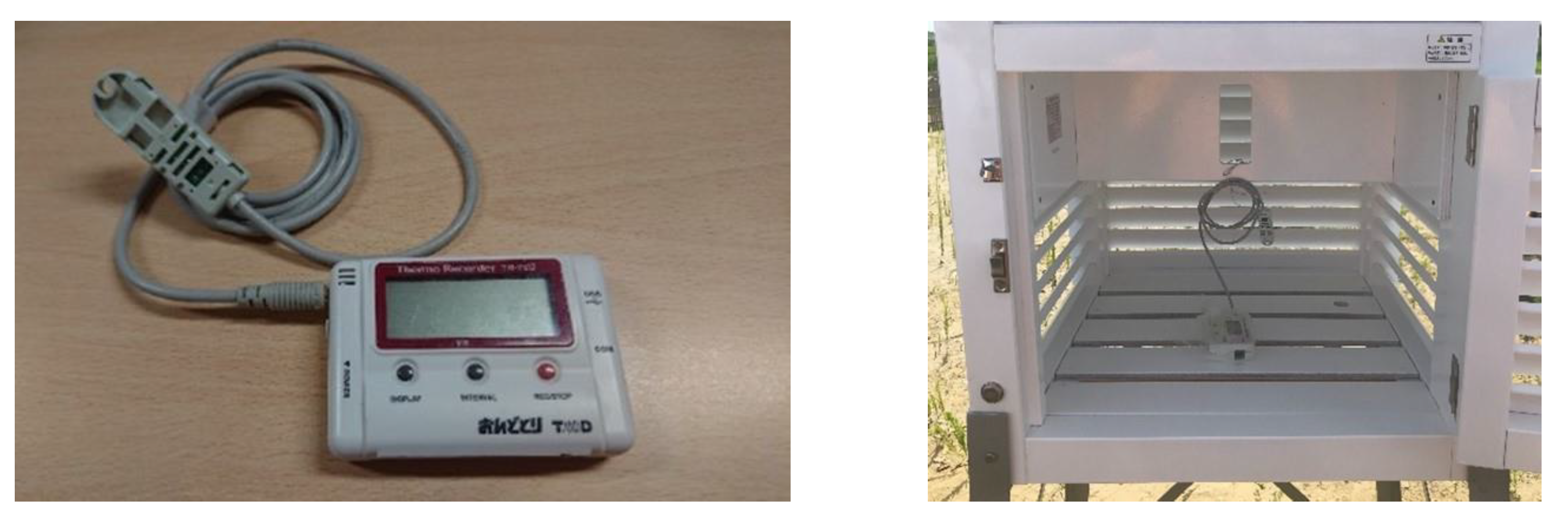
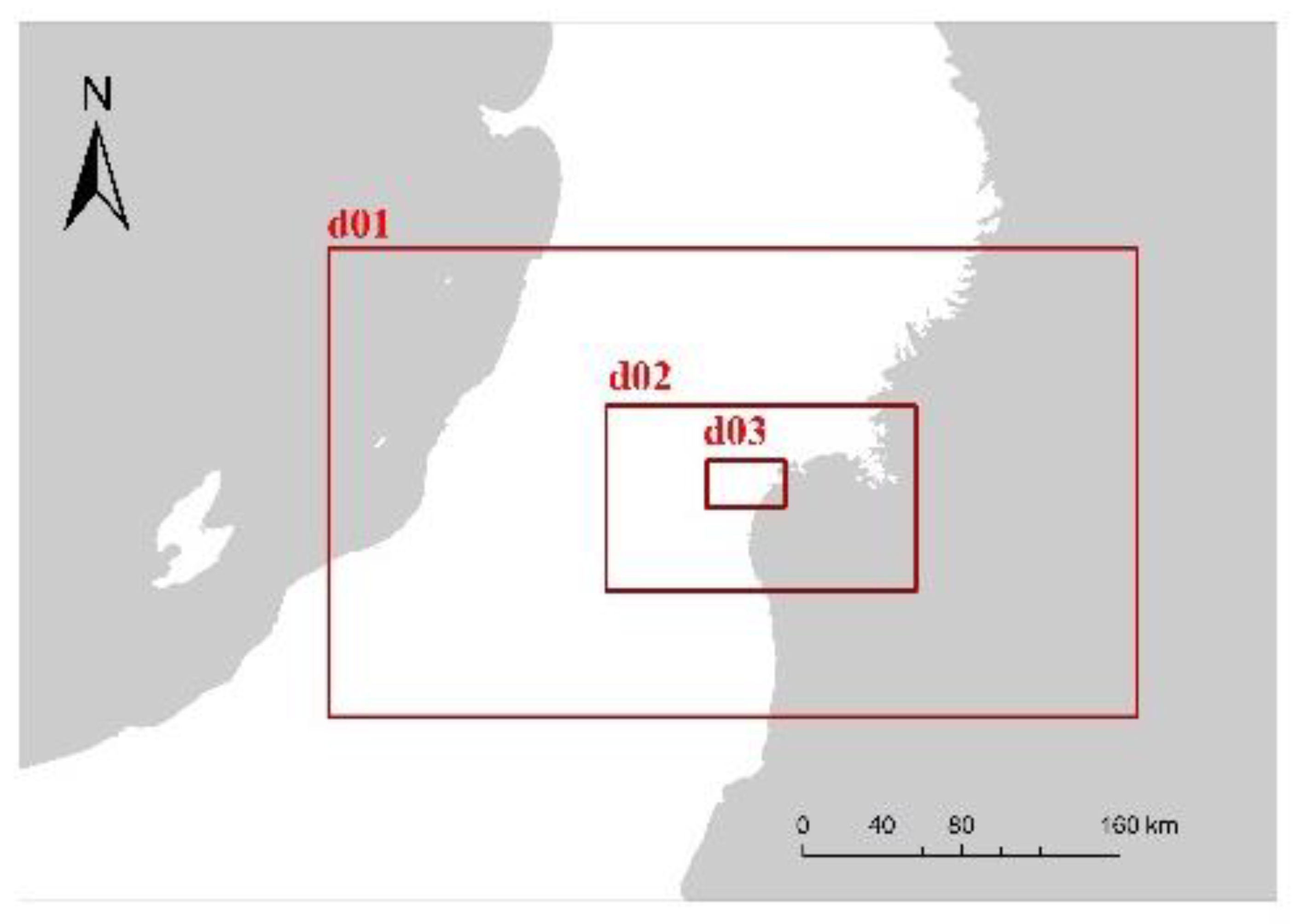

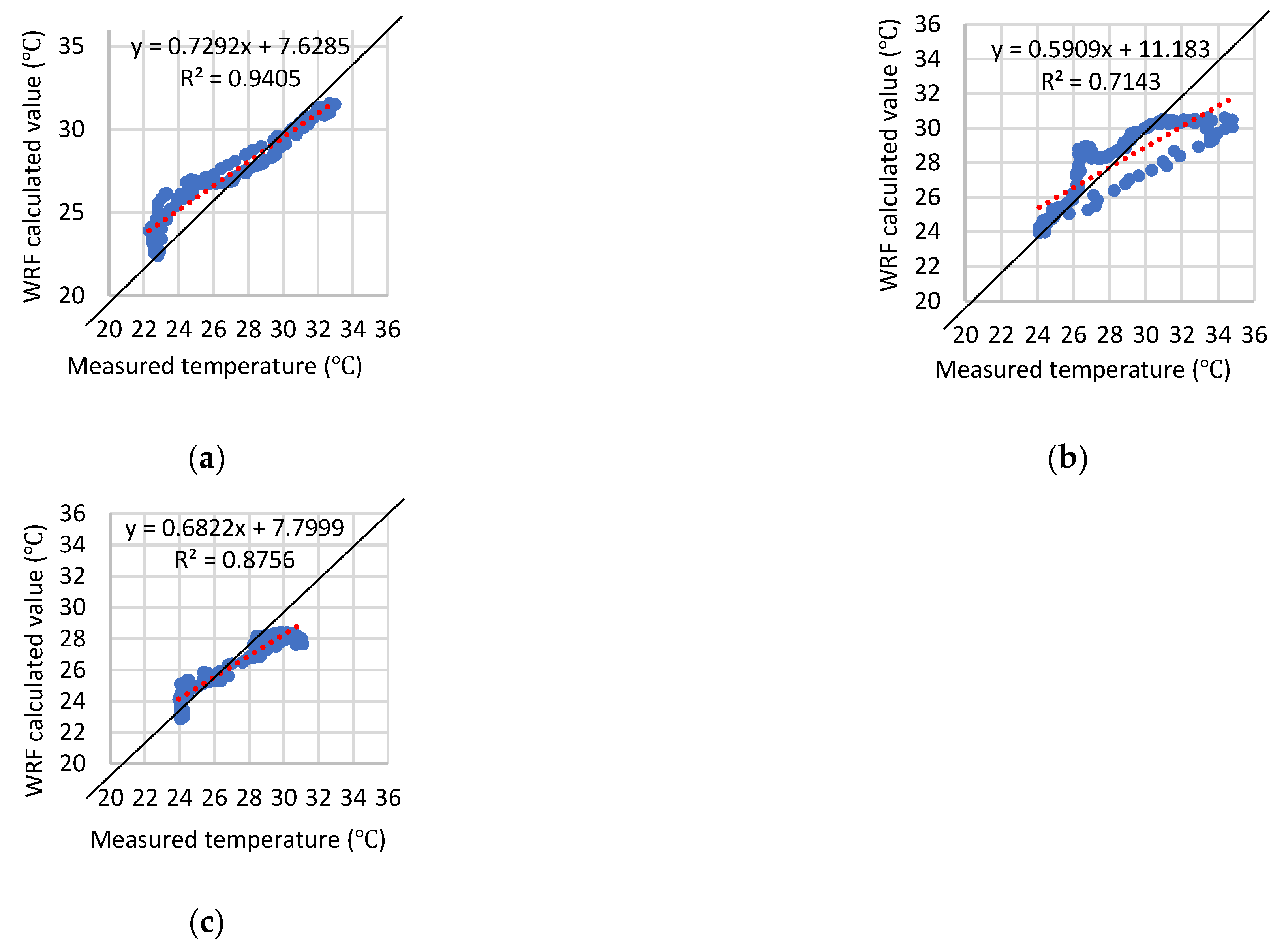
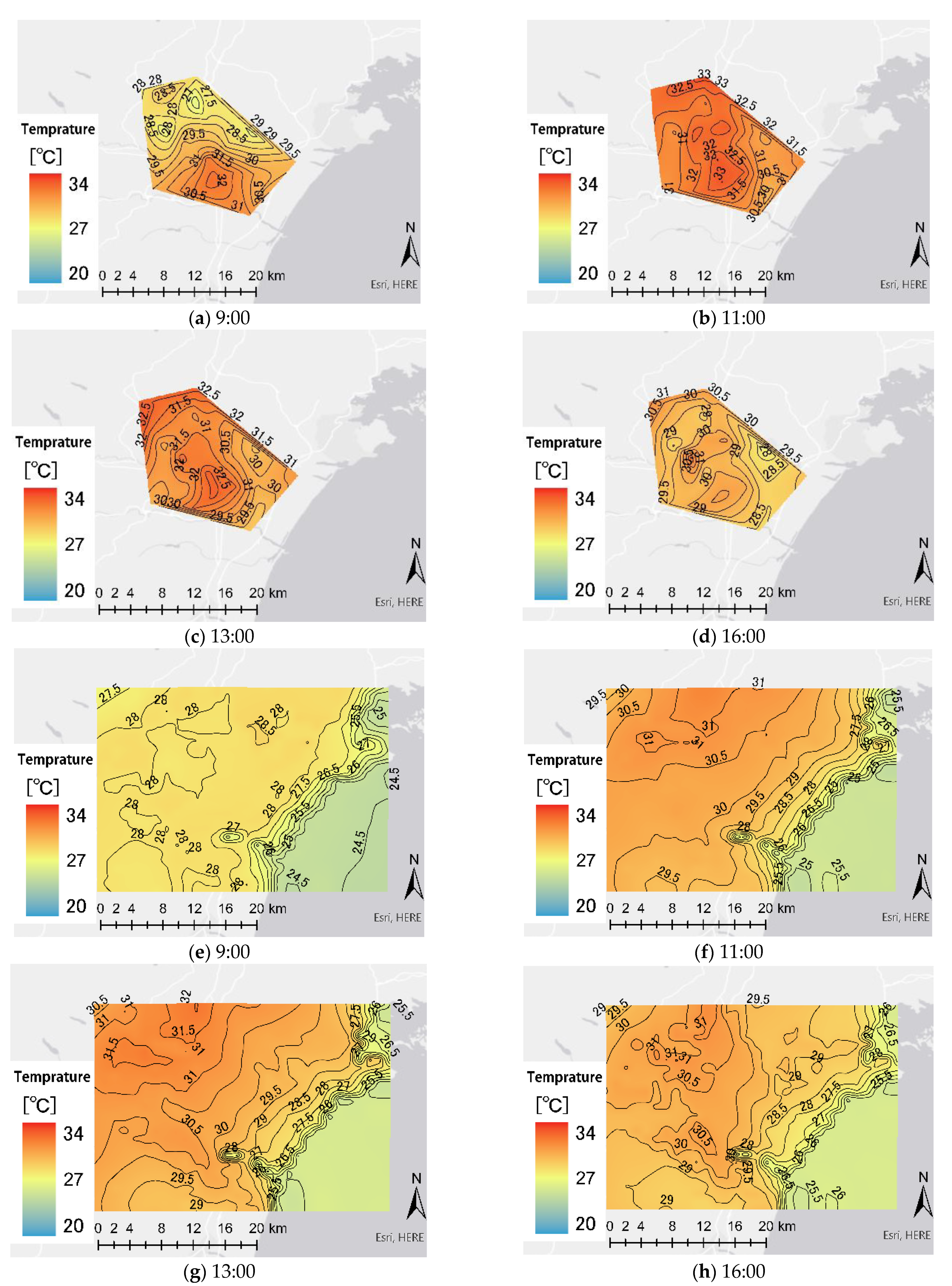


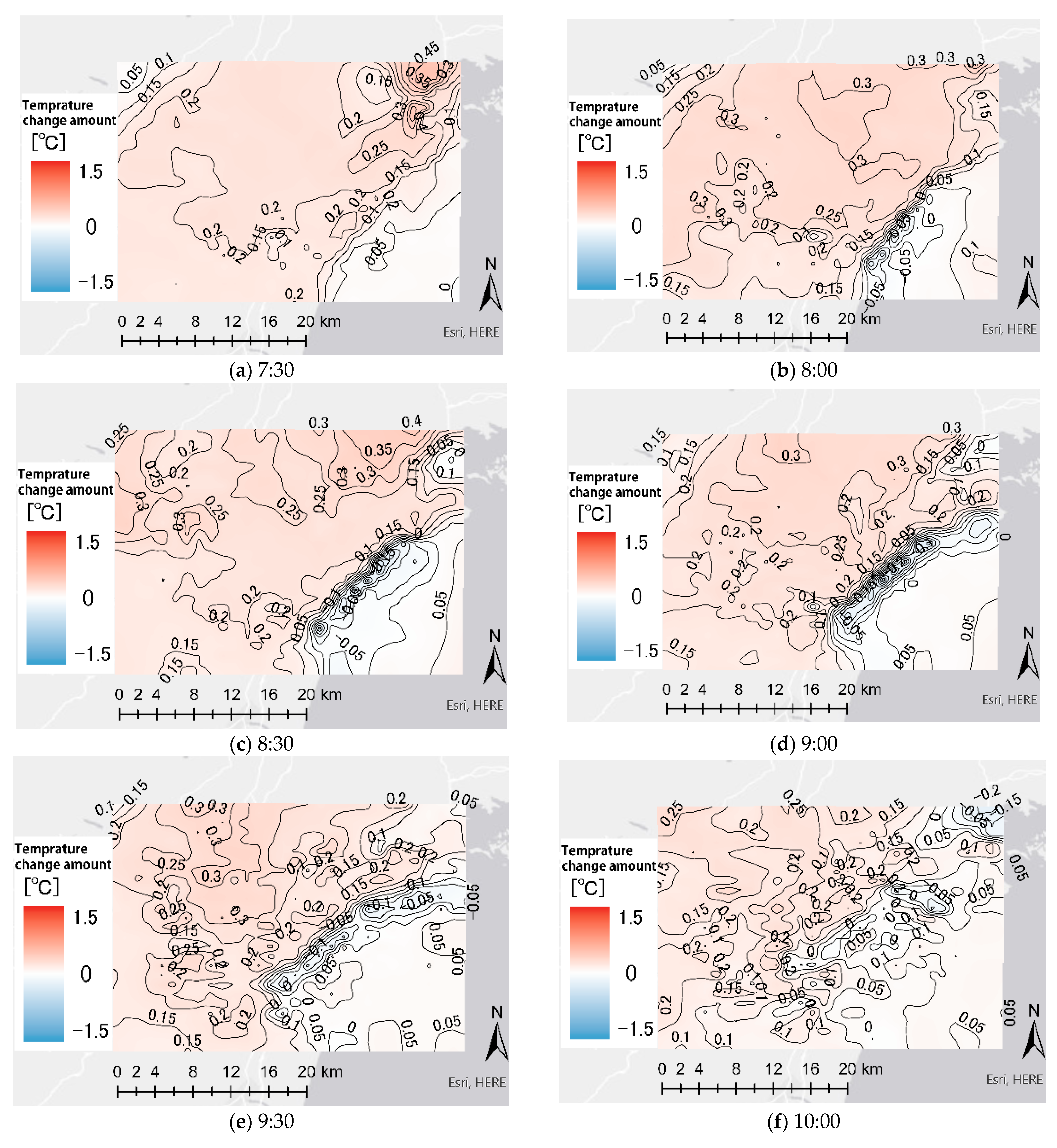
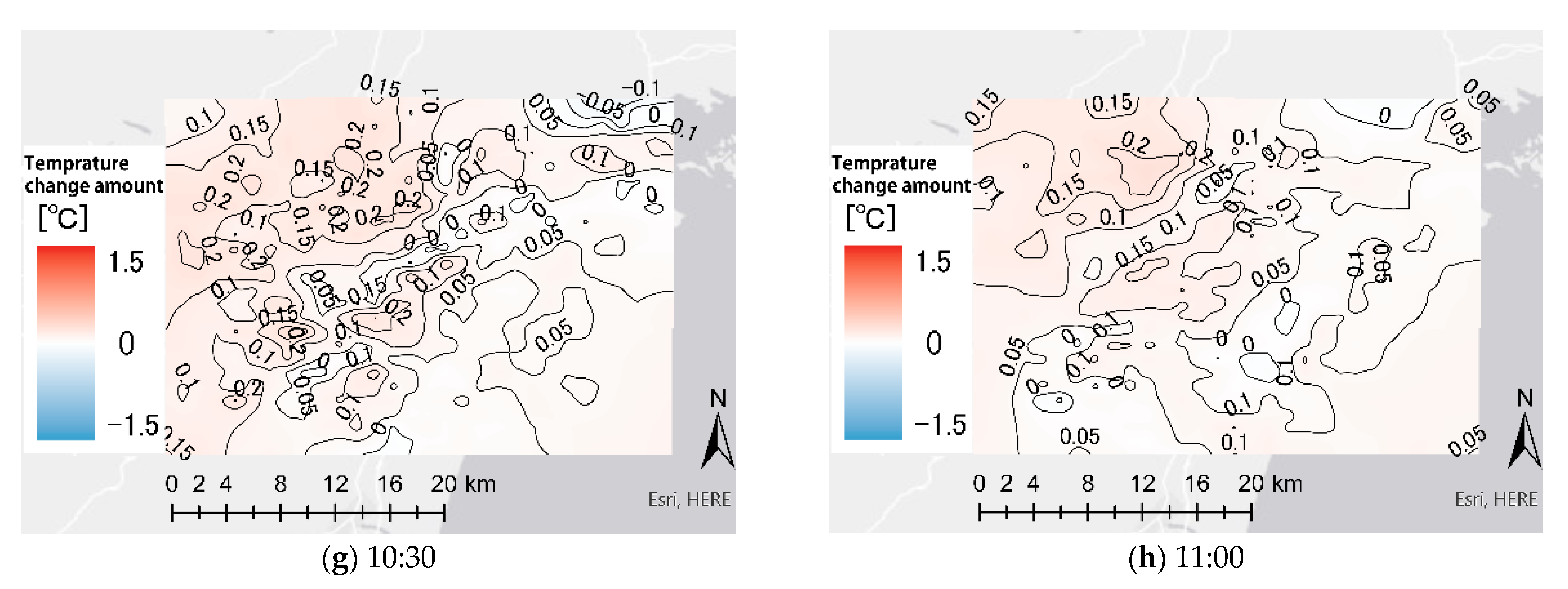
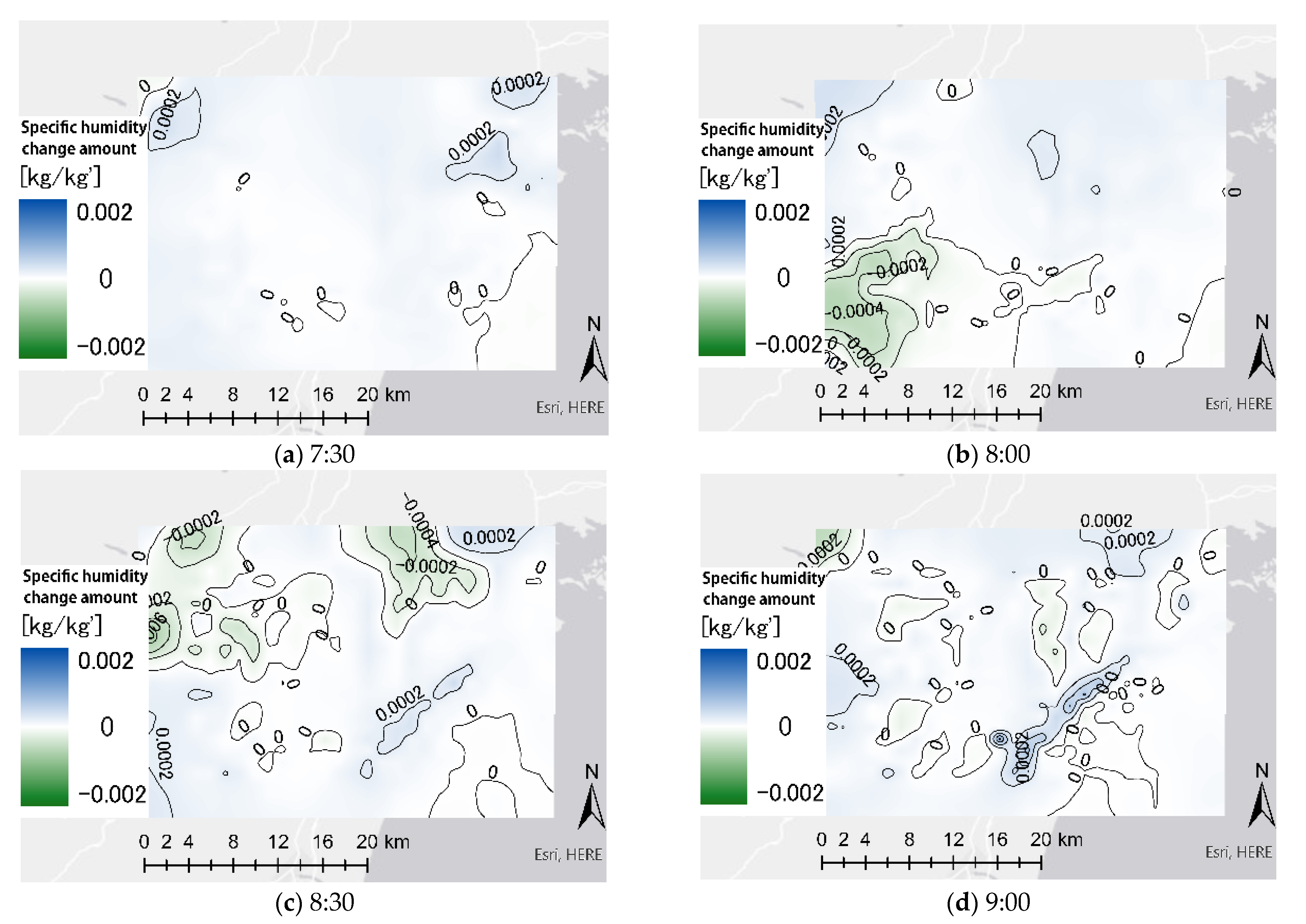
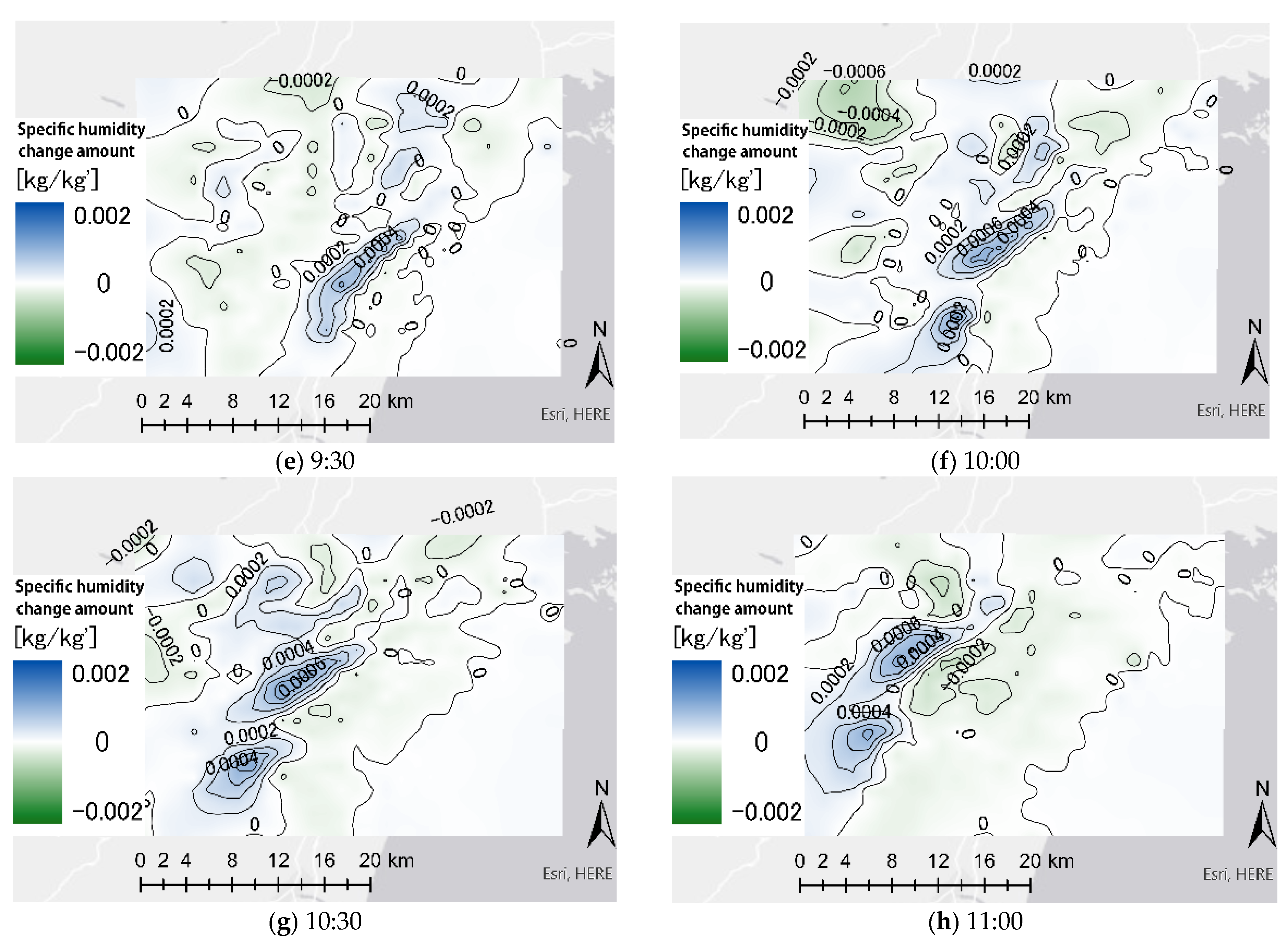


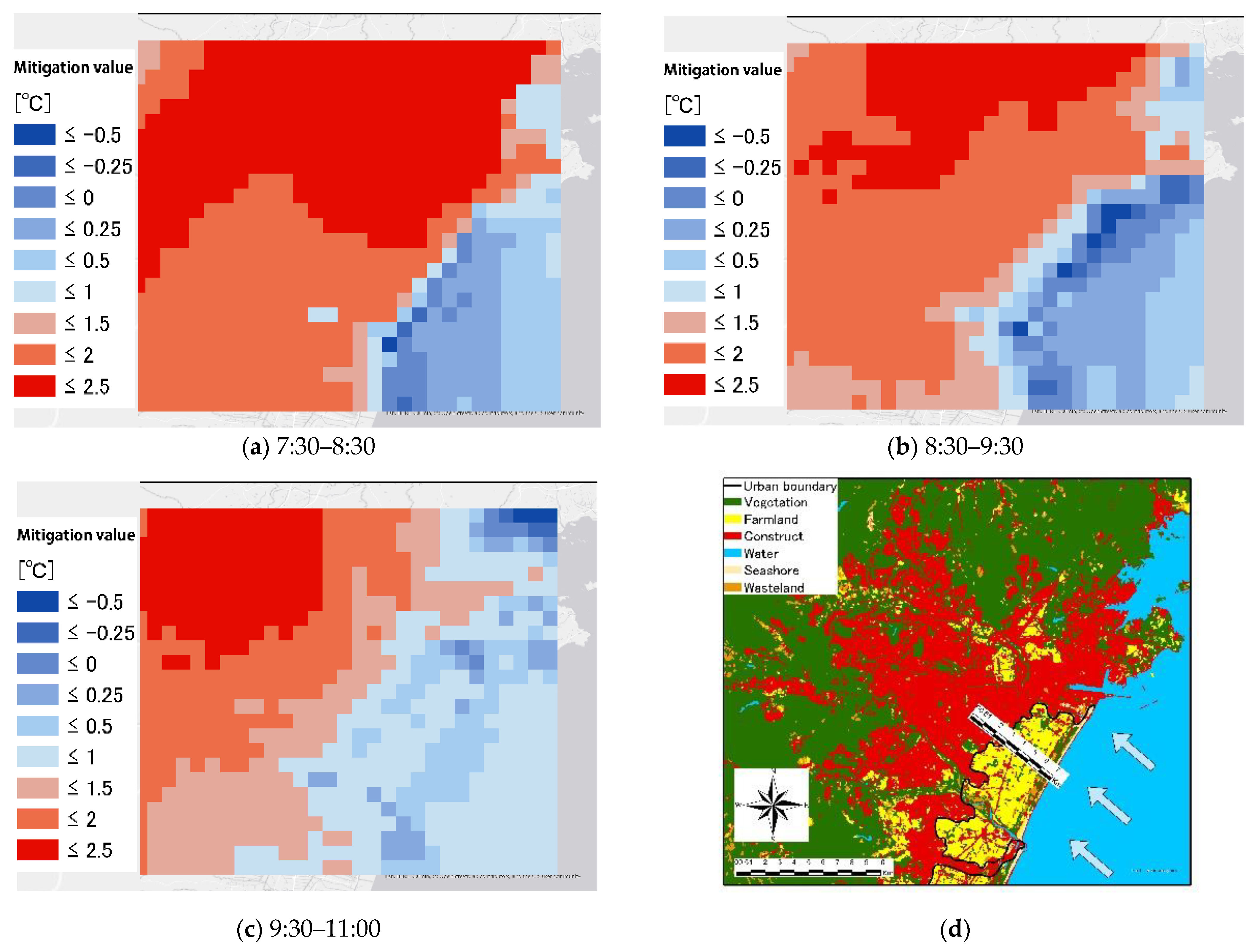
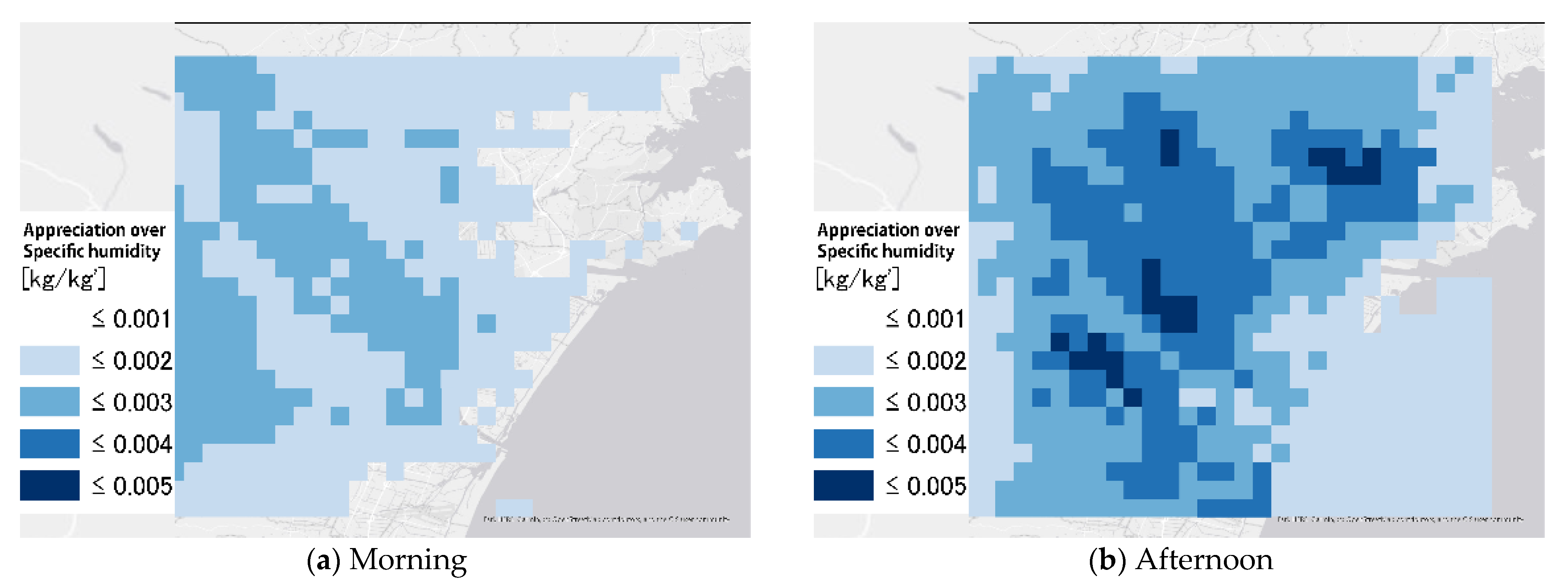
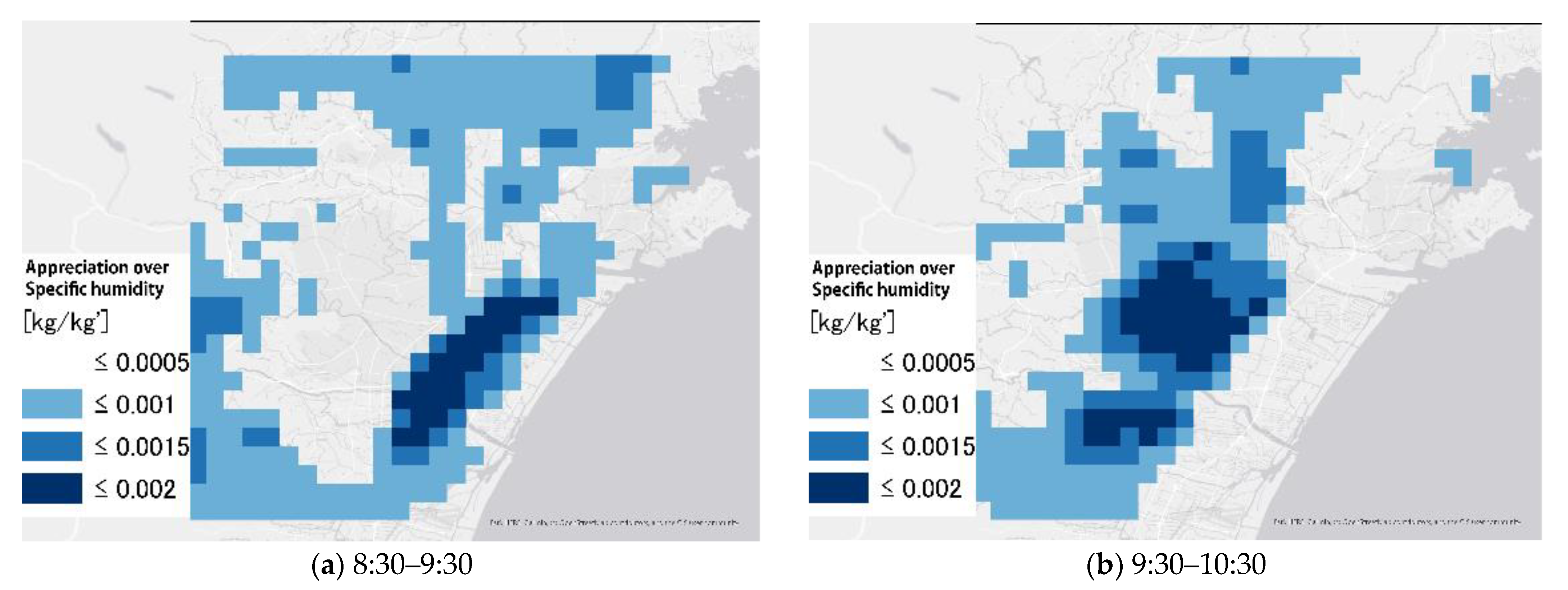
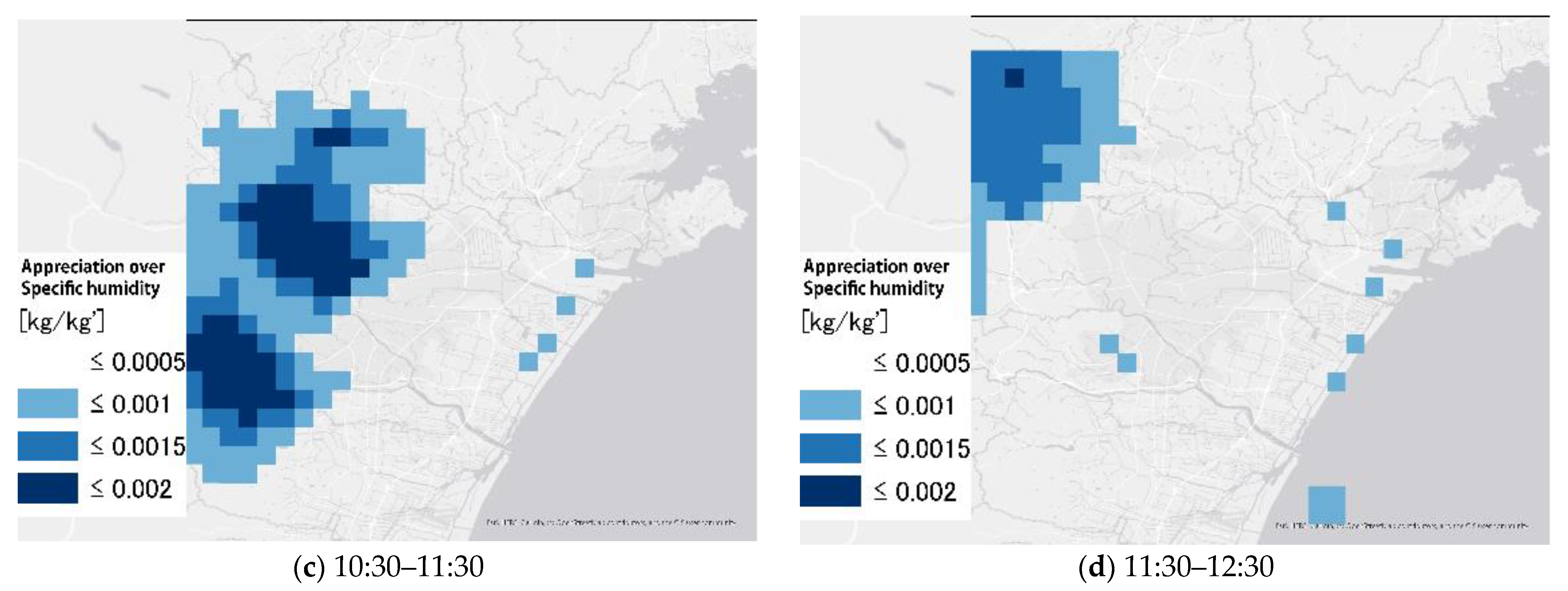
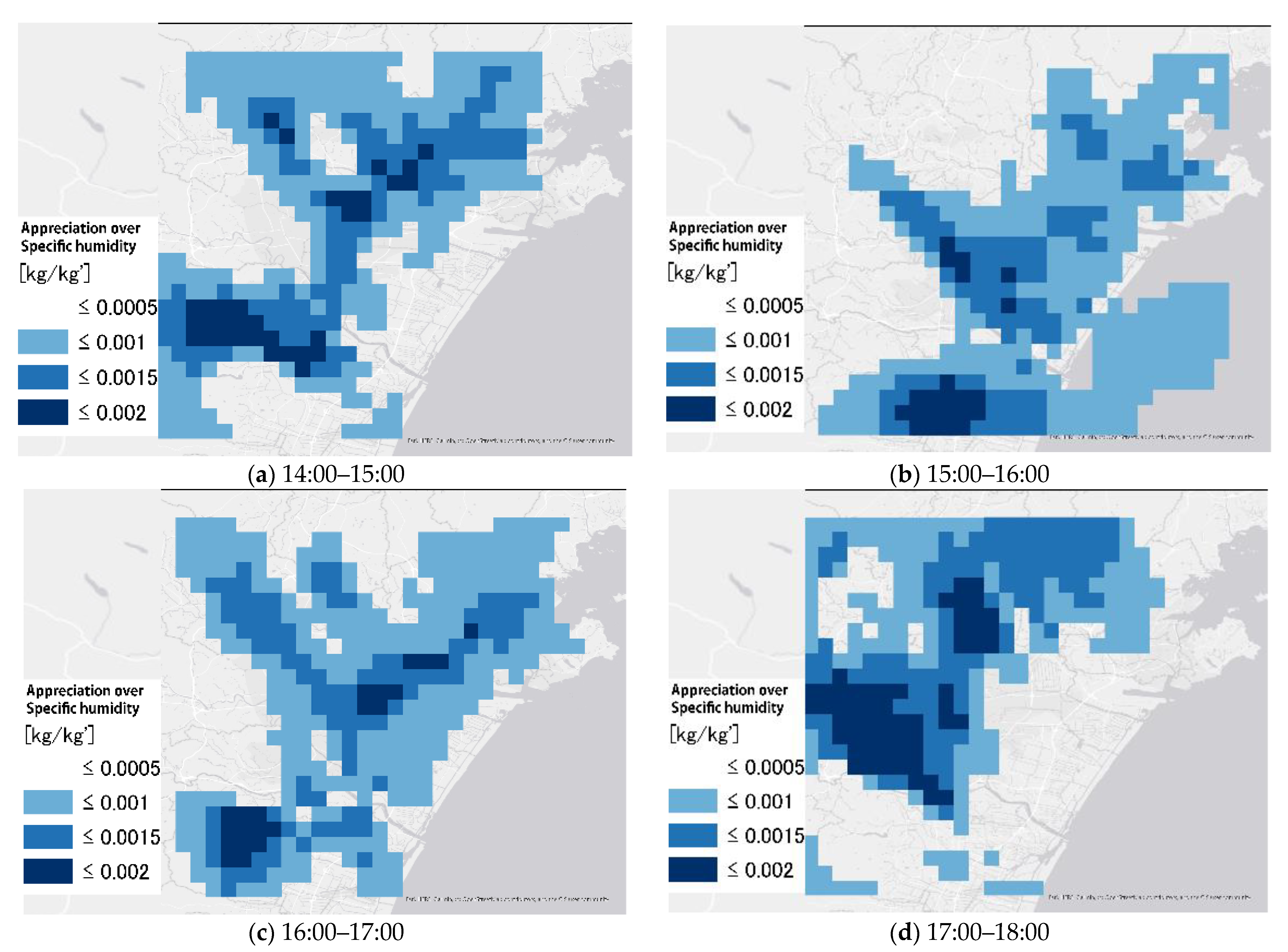
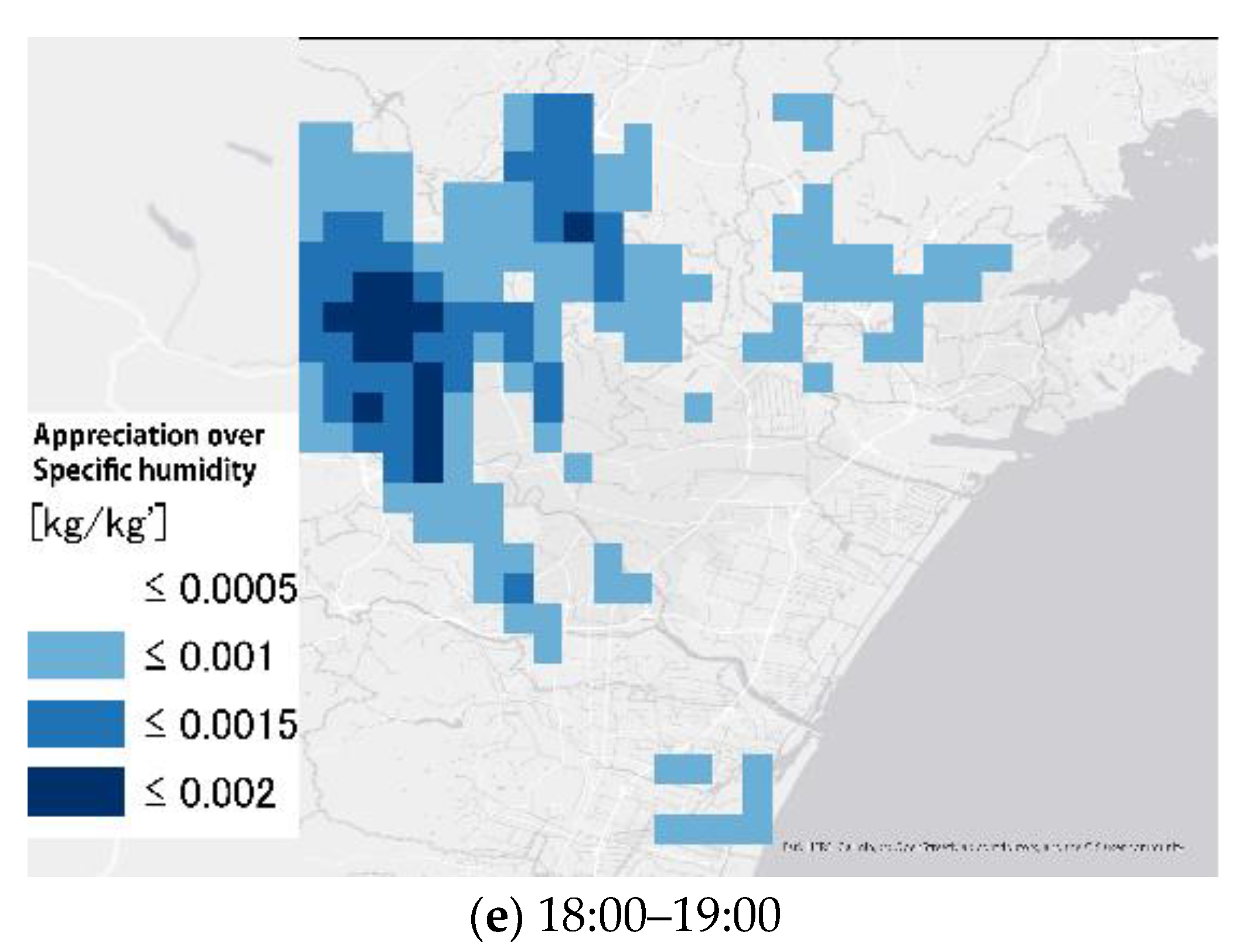
Publisher’s Note: MDPI stays neutral with regard to jurisdictional claims in published maps and institutional affiliations. |
© 2022 by the authors. Licensee MDPI, Basel, Switzerland. This article is an open access article distributed under the terms and conditions of the Creative Commons Attribution (CC BY) license (https://creativecommons.org/licenses/by/4.0/).
Share and Cite
Peng, S.; Kon, Y.; Watanabe, H. Effects of Sea Breeze on Urban Areas Using Computation Fluid Dynamic—A Case Study of the Range of Cooling and Humidity Effects in Sendai, Japan. Sustainability 2022, 14, 1074. https://doi.org/10.3390/su14031074
Peng S, Kon Y, Watanabe H. Effects of Sea Breeze on Urban Areas Using Computation Fluid Dynamic—A Case Study of the Range of Cooling and Humidity Effects in Sendai, Japan. Sustainability. 2022; 14(3):1074. https://doi.org/10.3390/su14031074
Chicago/Turabian StylePeng, Shiyi, Yusuke Kon, and Hironori Watanabe. 2022. "Effects of Sea Breeze on Urban Areas Using Computation Fluid Dynamic—A Case Study of the Range of Cooling and Humidity Effects in Sendai, Japan" Sustainability 14, no. 3: 1074. https://doi.org/10.3390/su14031074







